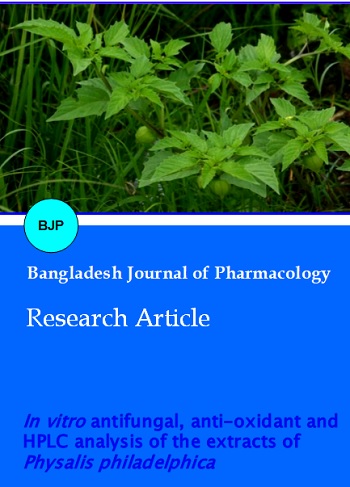In vitro antifungal, anti-oxidant and HPLC analysis of the extracts of Physalis philadelphica
DOI:
https://doi.org/10.3329/bjp.v12i3.31965Keywords:
Antifungal, Anti-oxidant, HPLC, Physalis philadelphicaAbstract
The different parts of Physalis philadelphica were evaluated for the antifungal, anti-oxidant and HPLC assay. The methanol extract of leaf showed inhibitory activity against Pencillium digitatum (58% ZI), Aspergillus flavus (95% ZI) and Rhizopus oryzae (96% ZI) at a concentration of 400 ppm. Strong anti-oxidant activities were found in different parts of the plant. The effects of different extraction solvents on the anti-oxidant activity and antifungal activity of the medicinal extracts were observed. The methanol extract from the leaf, stem, fruit and water fractions from the calyx exhibited strong anti-oxidant activity of 94, 89, 88 and 93% respectively. The ethyl acetate extract was found as a best solvent for the recovery of gallic acid in HPLC assay. No correlation was observed between the gallic acid and anti-oxidant capacity of the extracts.
Video Clip of Methodology:
11 min 13 sec: Full Screen Alternate
Downloads
211
167 Read
30

Published
How to Cite
Issue
Section
License
Authors who publish with this journal agree to the following terms:
- Authors retain copyright and grant the journal right of first publication with the work simultaneously licensed under a Creative Commons Attribution License that allows others to share the work with an acknowledgement of the work's authorship and initial publication in this journal.
- Authors are able to enter into separate, additional contractual arrangements for the non-exclusive distribution of the journal's published version of the work (e.g., post it to an institutional repository or publish it in a book), with an acknowledgement of its initial publication in this journal.
- Authors are permitted and encouraged to post their work online (e.g., in institutional repositories or on their website) prior to and during the submission process, as it can lead to productive exchanges, as well as earlier and greater citation of published work (See The Effect of Open Access).
